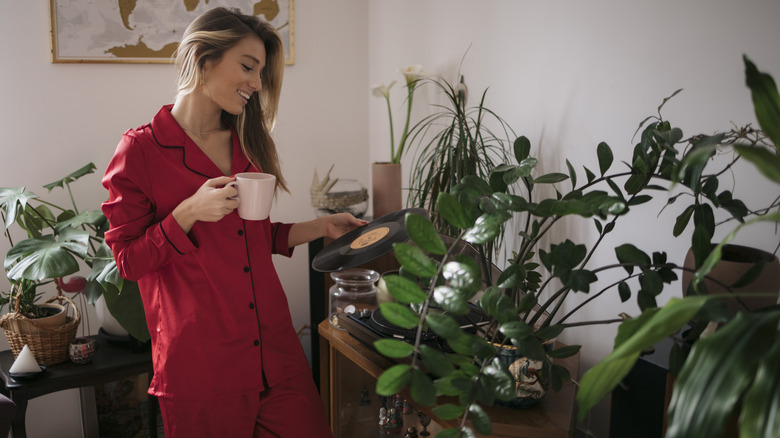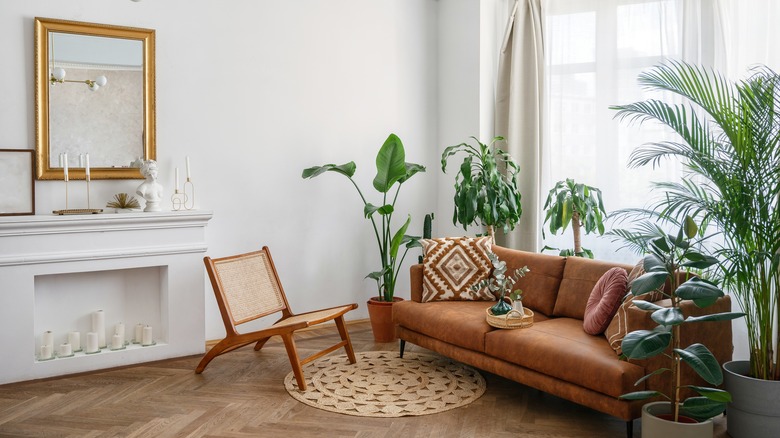Can Houseplants Actually Help With Your Home's Acoustics?
It's no secret that live plants can do a lot to transform an interior space. Besides providing fresh air and boosting your mood, plants generally make a room feel more unique, balanced, and energized. If you really needed another reason to decorate with a few indoor plants in every room in your home, adding greenery may also help to soften the acoustics of an echoing, open space. Sound waves are essentially vibrations in the air, which radiate throughout a room and bounce off of hard, smooth surfaces. When a sound wave bumps into something that's uniquely-shaped, the wave force can be absorbed or disrupted and is less likely to ricochet back into your ears. Houseplants, with their complex shapes, many layered leaves, and rough bark, are perfect for catching and disrupting sound wave patterns.
In the same way that a hearty hedge can reduce roadway noise in your front yard, houseplants actually create a textural sound barrier that absorbs and refracts excess noise in your home, making it easier to relax and focus. Unlike bulky furniture, curtains, or carpets (other items that can also soften acoustics), plants are generally affordable, won't add a lot to your cleaning list, and can work in many different aesthetics, including minimalism. Here's more information about why plants can absorb sound and the best kinds to use for noise reduction.
How plants absorb bothersome noises
Plants are a great acoustic solution for anyone, but especially those who prefer a clean, minimal, and spacious interior design look. They are frequently used in office buildings, libraries, and other public spaces to dampen sound without distracting from the interior beauty of the building, and they've been found to be quite effective. For instance, one 2005 study by Hanyang University showed that plants were effective at reducing noises and were most successful at decreasing lower-end frequencies like street rumbling, traffic, and sounds from the air conditioner. Because of this, sound-reducing plants are ideal for offices, music rooms, bedrooms or anywhere where you need to relax and limit distractions. Placing plants around the perimeter of the room is a simple way to catch noise and prevent it from echoing off the walls. On the other hand, if you want to break up an especially-large room, you can use greenery like a room divider between two connected spaces.
Plus, your plants may actually appreciate being placed in a noisy area! According to a 2020 study published by Plant Signaling & Behavior, when sound waves collide with plants, the vibration speeds up movement within the cells, leading to faster cell growth. Additionally, sound also boosts your greenery's strength and immunity, making them more resistant to pathogens, diseases, and drought. Therefore, placing your greenery in a noisy room and frequently talking to your plants may actually give them better odds of survival.
How to make the most of plant acoustics
When you're shopping for plants for sound absorption, you'll want to think big, dense, and fluffy. While all plants can help in small ways, large and tall plants will generally have the best noise-reducing effects. Some excellent options include majesty palms, snake plants, fiddle leaf fig trees, ZZ plants, monsteras, philodendrons, and ferns. In fact, according to a 2014 study by the University of Perugia, Italy, ferns (specifically Nephrolepis Exaltata), are one of the most effective plants for sound dampening, absorbing up to 98% of incident acoustic energy thrown their way. Other plants, like baby tears, were found to have strong absorption across a wider frequency range.
You can also use hanging and trailing plants to your advantage in tall rooms, encouraging them to trail and drape around shelves, cabinets, or stairways. Of course, you'll need to make sure that the plant's care requirements are met, as they still need to be in a space where they receive enough sunlight. Additionally, a 2016 quantitative study published by the Institute of Noise Control Engineering suggests that moss walls or "living walls" are also very effective for sound absorption. Overall, the more plants you use, the more effective they will be at absorbing noises.



